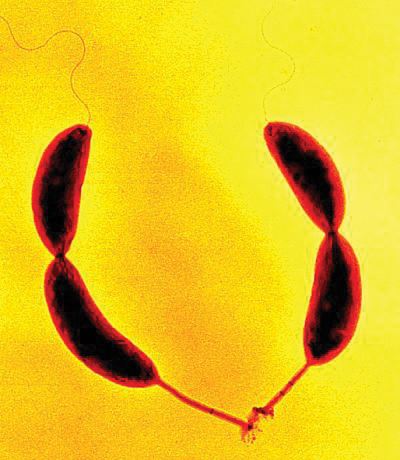Bacterial sphingolipids: Perhaps not as rare as we thought?
Among the ways cells adapt to changes in their environment, regulation of the lipidome is critical for maintaining cellular integrity. Species that lack temperature homeostasis adapt by modulating acyl chain saturation to resist changes in membrane fluidity. Bacteria such as Escherichia coli desaturate their fatty acids as temperatures decrease; the double bonds formed by acyl chain desaturation introduce kinks in the fatty acids that inhibit lipid packing and increase membrane fluidity to counteract the effects of lower temperature.
 Eric Klein’s lab showed that the Gram-negative aquatic bacterium Caulobacter crescentus synthesizes a novel glycosphingolipid when phosphates in its environment are limited.U.S. Department of Energy/Wikimedia Commons
Eric Klein’s lab showed that the Gram-negative aquatic bacterium Caulobacter crescentus synthesizes a novel glycosphingolipid when phosphates in its environment are limited.U.S. Department of Energy/Wikimedia Commons
Temperature is not the only environmental variable that necessitates membrane remodeling. In many settings, nutrient availability can vary widely. For example, nutrient levels in fresh-water lakes fluctuate with the seasons, and plant decomposition affects soil. In particular, oscillations in phosphate concentration can limit bacterial growth.
When phosphates are limited, the synthesis of membrane phospholipids becomes an obvious challenge. Studies have shown that alphaproteobacteria, such as Agrobacterium tumefaciens and Mesorhizobium loti, adapt to phosphate starvation by increasing production of diacylglycerol-based glyceroglycolipids and ornithine lipids.
In our lab, we recently showed that the Gram-negative aquatic bacterium Caulobacter crescentus responds to phosphate limitation by synthesizing a novel hexosyl-hexuronosyl-ceramide glycosphingolipid, or GSL. Ceramide-based GSLs are ubiquitous in eukaryotic organisms, but in bacteria they had been observed previously only in the Sphingomonadaceae family, where they function as a substitute for outer-membrane lipopolysaccharides, or LPS. Unlike Sphingomonas species, C. crescentus produces LPS even during phosphate starvation; in this organism, the GSLs appear to play a role in resistance to phage-mediated killing.
Now that we know that bacterial GSLs are not limited to just the Sphingomonadaceae, just how widespread are these lipid species? The honest answer is that we simply don’t know. While the lipidomes of many bacteria have been characterized, our findings in C. crescentus demonstrate that lipid abundance can vary with growth conditions. Indeed, previous characterizations in rich growth media did not identify GSLs in C. crescentus.
Another major challenge is that, unlike for eukaryotes, we do not know which enzymes are responsible for ceramide synthesis in prokaryotes. Only the enzyme that catalyzes the first step of ceramide synthesis, serine palmitoyltransferase, has clear homologues in bacteria as described in a recent review by Dominic Campopiano and colleagues. This implies that either (1) bacteria carry out the same synthetic chemistry as eukaryotes, but these enzymes diverged so long ago that the functionally equivalent proteins cannot be identified by sequence homology or (2) bacterial ceramide synthesis evolved independently using novel enzymes and/or synthetic pathways. If the genes required for ceramide synthesis are identified, researchers will be able to take a bioinformatic approach to finding additional species that might produce these lipids.
A growing body of work demonstrates that bacterially produced sphingolipids may play an important role in aspects of human health such as gut homeostasis and oral pathology. Uncovering the mechanism of prokaryotic ceramide synthesis will help determine how widespread these lipids are in bacteria and also may provide a novel route for pharmacological intervention.
Enjoy reading ASBMB Today?
Become a member to receive the print edition four times a year and the digital edition monthly.
Learn moreGet the latest from ASBMB Today
Enter your email address, and we’ll send you a weekly email with recent articles, interviews and more.
Latest in Science
Science highlights or most popular articles

E-cigarettes drive irreversible lung damage via free radicals
E-cigarettes are often thought to be safer because they lack many of the carcinogens found in tobacco cigarettes. However, scientists recently found that exposure to e-cigarette vapor can cause severe, irreversible lung damage.

Using DNA barcodes to capture local biodiversity
Undergraduate at the University of California, Santa Barbara, leads citizen science initiative to engage the public in DNA barcoding to catalog local biodiversity, fostering community involvement in science.

Targeting Toxoplasma parasites and their protein accomplices
Researchers identify that a Toxoplasma gondii enzyme drives parasite's survival. Read more about this recent study from the Journal of Lipid Research.

Scavenger protein receptor aids the transport of lipoproteins
Scientists elucidated how two major splice variants of scavenger receptors affect cellular localization in endothelial cells. Read more about this recent study from the Journal of Lipid Research.

Fat cells are a culprit in osteoporosis
Scientists reveal that lipid transfer from bone marrow adipocytes to osteoblasts impairs bone formation by downregulating osteogenic proteins and inducing ferroptosis. Read more about this recent study from the Journal of Lipid Research.

Unraveling oncogenesis: What makes cancer tick?
Learn about the ASBMB 2025 symposium on oncogenic hubs: chromatin regulatory and transcriptional complexes in cancer.

